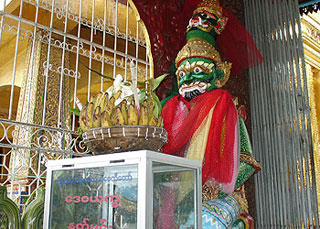Thanlyin is situated at the confluence of the Yangon and Bago Rivers; to be exact. on the southern bank of the Bago River. To the south of Thanlyin is a ridge named Utaringa Kon in history but locally known as Shin Mwe Nun Kon. It is on this ridge that Kyaik Khauk Pagoda stands.
The colonial town of Syriam was built by the British for it’s port and petroleum refinery plant. It is also a sub-urban town right a few miles away from Yangon. across 1.5 mile-long bridge
Interesting Places
KYAIK KAUK PAGODA


The Kyaik Kauk Pagoda is built on a hillock on the road to Kyauk Tan. It is an imposing golden stupa similar to the Shwe Dagon pagoda.
Thanlyin formerly known as Syriam is just across the river. spanned by one of the longest bridges in Myanmar. A half-an-hour’s drive by car or train.
History of Kyaik Kauk
Pagoda Its legend dates its building far back to the time of Emperor Asoka the great king of India. Two hundred and thirty six years after the demise of the Lord Buddha. Emperor Asoka who embraced Buddhism after he heard and understood the Buddha’s dhamma. held the Third Buddhist Council. Maha Thera Ashim Moggalana Putta Tisa presided over the Council. At his advice. the Council with the royal patronage and support of Asoka sent out religious missions to nine places and nine countries to spread the Dhamma. Buddha’s Teachings. The mission sent to Suvannabhumi [Thaton] was headed by Maha Theras Sona and Uttara who successfully carried out their missionary works there. One of their pupils and assistants Ashin Somaga was sent on a mission to Pauk-khara-wady or Dagon. He resided at this place and visited Let-kha-ya and Siha islands and propagated the Buddha’s teachings there. A hermit named Khaw Laka who lived on Utaringa Kon. after hearing the Dhamma became a bhikkhu. Later Ashin Somaga and Bhikkhu Kaw Laka went to Pataliputra in India and requested Emperor Asoka to give them some sacred relics of the Buddha for worship. They received 24 strands of the Buddha’s hair. They returned to Siha Island and when they reached the Pada jetty. they left two sacred hairs to be enshrined in a pagoda built there. Later these hairs were re-enshrined in a pagoda now know as Kyaik DeiYa.
The remaing hair relies were enshrined each in one pagoda at each of 16 Villages such as
(1) Ta Hmaw Village
(2) Ka Lun Pun Village
(3) Ka Hnein Village
(4) Ka Hnaw Village
(5) Mon Naw Village
(6) Tha Laing Village
(7) Hmaw Wun Village
(8) Kan Ti Village
(9) Kha Pi Village
(10) Tha Naw Kaik Village
(11) Ah Lwei Eake Village
(12) Pa Wun Gai Village
(13) Pa Yin Village
(14) Wi Thone Village
(15) Pa Ro Village
(16) Than Hlyin Village [Saga Village]
and the remaing six hairs were enshrined in a pagoda built on Utaringa Kon [now called Hlaing Pok Kon].
The pagoda on Utaringa Kon was built by King Cula Thirimasoka of Thaton in the Buddhist Era 241. It was a big structure built of laterite stone. Because this place was where Ashin Bhikkhu Kaw Laka resided. the Pagoda came to be known as Kaw Laka Pagoda. This name in course of time corrupted to Khauk Pagoda or Kyaik Khauk in Mon.
YE LE PAYA


Ye Le Paya at Kyauk Tan means the pagoda in mid-stream built on a laterite reef. It was built by King Zeyasana. the seventh king of the Pada Dynasty in the third century BC. The first pagoda was only 11 feet high. The pagoda complex comprises several buildings including a monastery. Pilgrims and visitors are ferried across to the pagoda. One can feed shoals of long river catfish. which surface to snatch tit-bits of food thrown at them. When food is thrown. they reach out to snap at it. revealing their size. which can reach up to one meter in length.
NATIONAL RACES VILLAGE
The National Races Village is an interesting place for both local and foreign visitors.





